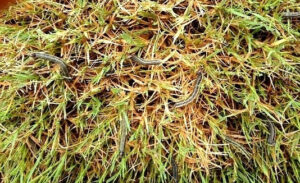What are Armyworms?

Armyworms are destructive pests that consume turf grasses, but they’ll feed on vegetables and other plants when food is scarce. They eventually become moths, but it’s the worm-like larvae stage that cause the most damage. When large numbers are present in your lawn, armyworms may seem to march side-by-side like an army battalion. Heavy infestations can destroy lawn grasses i
n just a few days.
Armyworm Identification: Several species of armyworms affect lawns and crops in the United States. In the larval stage, they typically measure 1 1/2 to 2 inches long. Their heads may vary in color, but they have a distinctive inverted “Y” mark. Armyworm bodies have a series of green, yellow, red or brown stripes down their sides and backs. Adult armyworm moths measure about 1 1/2 inches across. Their front wings are dark gray with light and dark splotches, but their hind wings are pale gray-white.
Signs/Damage of Armyworms: Small brown lawn patches are often the first clue of an armyworm problem. The pests may leave grass blades ragged or chew just the green layer, creating a transparent “windowpane” Once the Armyworms are gone, then what? look. Grass may be sheared to the ground, creating bare spots in your lawn. When feeding on corn and other plants with larger leaves, these pests may leave rows of matching holes.
After an infestation is discovered, a commercial-grade pesticide application along with seeding will have the lawn back in shape in no time.
If you suspect you have Armyworms in your lawn. There is a treatment (additional cost) available to help stop the spread.
Call us (513) 271-5665, (513) 212-0216 or email ([email protected]) for more information and to treat for armyworms.
Once the Armyworms are gone, then what?
In almost all cases, any lawn that is lying down and discolored is dead and will require new seed. The best way to introduce new seed to these areas is to aerate and overseed.
Schedule your aeration and overseed when calling about armyworm treatment.
